
Innocence of Muslims (Again)
Apparently it’s a gift that keeps on giving. There’s simply no end to the Innocence of Muslims story. Now the U.S. Ninth Circuit Court of Appeals has ruled that Google must remove from YouTube all current versions of Mark Basseley Youssef’s anti-Islam provocation. (Click here for Maura Dolan’s February 26, 2014 report in the Los Angeles Times.)
Though it didn’t rate even a mention at last year’s Oscars, this turkey ranks in my book as one of the major filmic events of 2012, just on the basis of its international impact. I consider that a notable achievement in lens-derived imagery, and incorporated its arrival on the global stage into my coverage of the imagistic component of Election 2012.
The grounds for the Circuit Court’s decision merit the attention of photographers and filmmakers. Per earlier reports, one of the actresses in the film, Cindy Lee Garcia, sued for its removal from YouTube after various Muslim clerics issued fatwas against the film’s producer, director, cast, and crew. Garcia premised an amended claim on the issue of copyright violation. In brief, she argued that she’d never signed a release for her performance, whose copyright and subsidiary rights thus remained hers. (Click here for the complaint, and here for a September 2012 clip of Garcia explaining her position.)
Beware of Synecdoche
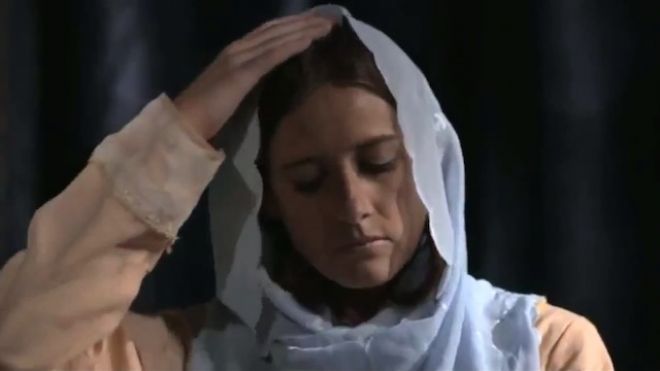
Cindy Lee Garcia, “Innocence of Muslims” (2012), screenshot.
As I suggested in summarizing her filing in a February 20, 2013 post, “If true, that argument could in fact hold water. Absent such a release (click here for a standard version), Garcia would retain many rights to her performance, perhaps including approval of any published version.” Chief Judge Alex Kozinski of the Ninth Circuit Court and one of his two colleagues on that bench seems to have come to the same conclusion. It appears from the court’s written opinion that Google’s lawyers failed to produce as evidence any standard release or comparable documentation signed by Garcia.
Two important points: First, Garcia’s claim to copyright pertains only to the 5-second clip of her, the voiceover to which makes her appear to say “Is your Mohammed a child molester?” With that removed, anyone could re-post an edited version of the trailer on YouTube, and YouTube could leave it up without violating the court’s order. Presently, the only way for Google and YouTube to comply involves taking down the entire film, because they can’t excise that clip. But that’s not Garcia’s fault; her complaint does not constitute an attempt to prevent distribution of the entire 14-minute film.
Who Owns Your Image?
Second, dissenting Circuit Court Judge N. R. “Randy” Smith (one of former President George W. Bush’s appointees) surely errs when he asserts that an actor’s performance in a film is not copyrightable by the actor. Were that so, all legal obligations for an actor’s filmic performance would get fulfilled when the actor showed up to perform as instructed and the producer or his delegate paid the agreed-upon sum for that labor.
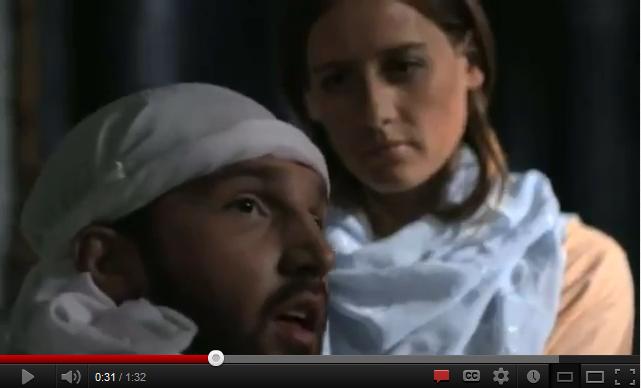
“Innocence of Muslims” (2012), screenshot.
In point of fact, standard film-industry practice involves the additional step of the performer signing a contract (commonly called a “release”) in which the performer “hereby give(s) [Production Company Name], their licensees, successors, legal representatives, and assigns the absolute and irrevocable right and permission to use my name and to use, reproduce, edit, exhibit, project, display, copyright, publish and/or resell photography images and/or moving pictures and/or videotaped images of me.” (My emphasis; click here for a standard version of this form, from which I’ve excerpted the preceding wording.) For the same reason, still photographers who intend to use images for commercial purposes commonly get their subjects to sign a comparable “model release.”
Since a film as a whole can be copyrighted, and said copyright covers all the individual performances conglomerated in the film, then those separate performances are subject to copyright. If the copyright and other rights listed in the release can be “given and assigned” by the performer to someone else, they must first be held by the performer. And, according to the law, copyright can’t get transferred “implicitly,” to use Judge Smith’s word; such a transfer requires written documentation.
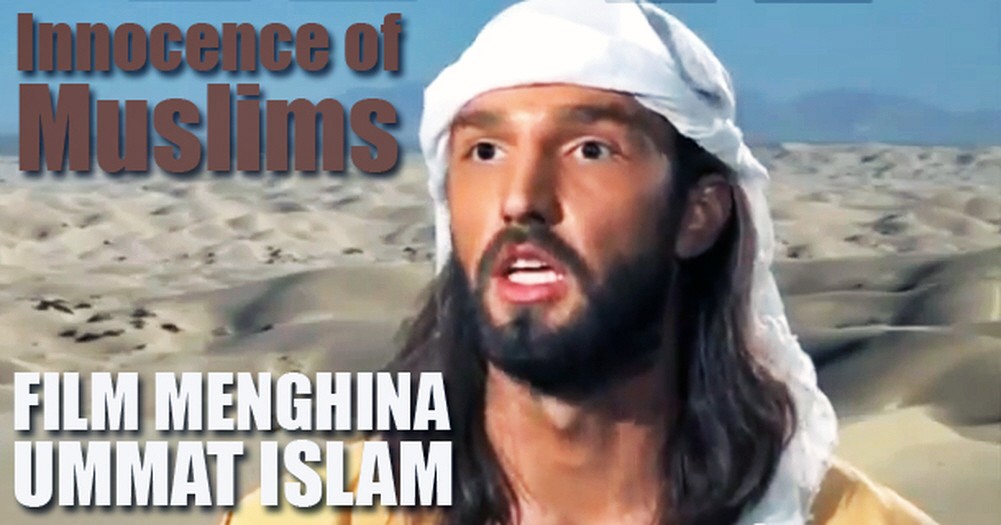
“Innocence of Muslims” (2012), title card.
Garcia has claimed that she never signed any release such as the law requires. In the case of a claim of copyright violation the burden, contrary to Smith’s assertion, is not on the plaintiff to prove that no release or other transfer of rights exists; the defendant has the obligation to produce it. Unless and until Google’s lawyers (or Youssef) put into evidence a legally binding release, according to the law Garcia transferred no rights to Youssef, she retains copyright, and her fleeting but potent appearance in the film violates the law. If so, the same would hold true for the film’s other actors, should they pursue claims on the same grounds.
You don’t have to be a lawyer (and I’m not one) to understand that. I find it shocking that a judge on the Ninth Circuit Court — even a Dubya appointee — didn’t bother to inform himself about the basics of copyright law before issuing his dissent.
Please Welcome … The Supremes!
That’s quite aside from the issue of fraud. In the decision, made by a 2-1 majority, Judge Kozinski wrote, “The film differs so radically from anything Garcia could have imagined when she was cast that it can’t possibly be authorized by any implied license she granted. … A clear sign that Youssef exceeded the bounds of any license is that he lied to Garcia in order to secure her participation, and she agreed to perform in reliance on that lie. … Youssef’s fraud alone is likely enough to void any agreement he had with Garcia.” Presumably the fraud would include misrepresenting the nature and purpose of the film, as well as overdubbing Garcia’s recorded lines with someone else voicing anti-Muslim sentiments.
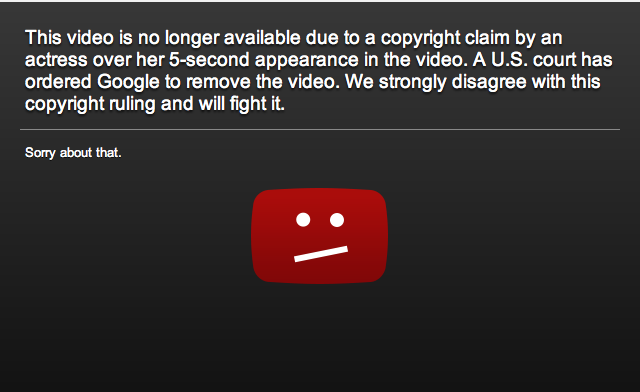
“Innocence of Muslims,” YouTube screenshot, February 28, 2014
The verdict, effective as of February 26, required Google to remove all copies of the film from YouTube within 24 hours and take “reasonable measures” to prevent it from being re-uploaded. As I write this, at 7 p.m. EST on February 26, the film is unavailable at Google.
The case has been sent back to a lower court, with instructions to issue a similar temporary ban. Google has pledged to appeal. Pending the outcome of that appeal, the court has ordered the video to remain offline. The case may end up before the U.S. Supreme Court.
Click here for legal expert Eugene Volokh’s analysis of the decision (with which he agrees), and his prediction of the grounds on which Google might pursue its appeal successfully. Click here for a strong dissent by Techdirt’s Mike Masnick, at the end of which you’ll find the actual court opinions (majority and minority), along with the court order.
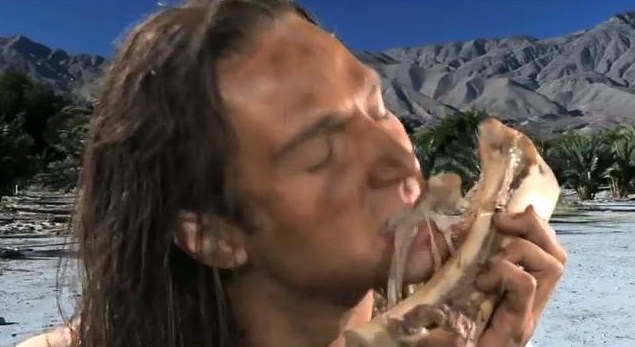
“Innocence of Muslims” (2012), screenshot.
The video will remain online at other sites, including sites throughout the Middle East, so this action has mostly symbolic value vis-a-vis Garcia’s minor role in Youssef’s project. Whether this will get her off the hook with the mullahs (she’s received numerous death threats, and moved out of her home) remains to be seen. Maybe there’s an application process for that.
(Note: I’ve taken to referring to this provocateur as Mark Basseley Youssef because, according to several newspaper accounts, that’s his current legal name. The Circuit Court opinion lists him as follows: “Nakoula Basseley Nakoula, An Individual, Aka Sam Bacile; Mark Basseley Youssef; Abanob Basseley Nakoula; Matthew Nekola; Ahmed Hamdy; Amal Nada; Daniel K. Caresman; Kritbag Difrat; Sobhi Bushra; Robert Bacily; Nicola Bacily; Thomas J. Tanas; Erwin Salameh; Yousseff M. Basseley; Malid Ahlawi.” Right.)
Man About Town
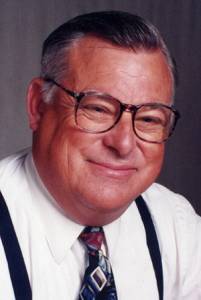
Pastor Wiley Drake
Meanwhile, having served his time for assorted parole violations, Youssef was released from a Los Angeles prison on August 15, 2013, to a halfway house for completion of his sentence. On September 26, 2013, officially freed from federal custody, he left the halfway house, and was “released to Pastor Wiley Drake of First Southern Baptist Church in Buena Park,” which has “taken him in.”
Apparently, as Youssef has adamantly refused to make any apology for his debut production, this means that he’s in hiding from Islamists eager to fulfill the fatwa still in effect against him.
Drake, a controversial minister and radio host, was the vice-presidential candidate for the America’s Independent Party ticket in California in 2008. An advocate of “imprecatory prayer,” which involves beseeching the Almighty to afflict and destroy evildoers, Drake has prayed for the death of President Obama. Strange bedfellows, he and Youssef (not that there’s anything wrong with that). I wouldn’t care to sample whatever they’ll cook up together.
Now Read the Book
While doing his time in the pokey, the man behind Innocence of Muslims, under the name Nakoula Basseley Nakoula, supposedly penned a self-published book he calls Innocence. Published on August 28, 2013 (just after his release from prison), paperback in format, 356 pages long (or maybe 314, or maybe 292). Listed at $22.49, this work claims to contain “The original script & storyboards for Innocence of Muslims.” Amazon’s main page for the book lists the publisher as Basseley Nada, but the book’s title page gives it as KTMA Co. Press. ISBN 13: 9780615873121 ISBN 10: 061587312X.
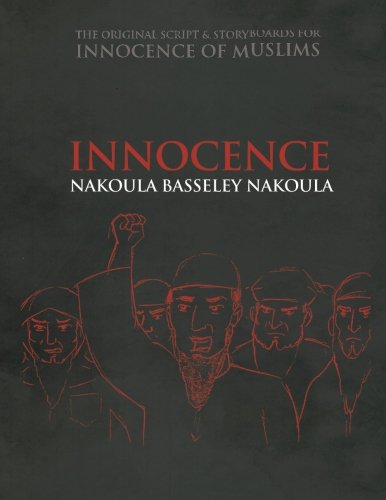
Nakoula Basseley Nakoula, “Innocence” (2013), cover
Nakoula/Youssef writes, “I dedicate this book to Ambassador Chris Stevens, Information Officer Sean Smith, former Navy Seals Tyrone Woods, and Glen Doherty; and to every son who has lost his father; to every mother or father who has lost her son or daughter; and to every person all over the world lost his life [sic] or has been injured because of the culture of death and terrorism. I would like to tell you all you are not forgotten.”
You’ll find that dedication, and the publishing information about the book, at Amazon. Along with this statement: “Out of Print–Limited Availability.” The “Look Inside” feature at ChezBezos shows several storyboards and scraps of script, plus Nakoula/Youssef’s introduction.
I qualify my description of its contents carefully because I can find no evidence whatsoever that this book actually exists. It has received no reviews or online discussion — certainly odd for so immediately high-profile and controversial a work. No bookseller has a used copy listed for sale, at any price; all listings of it show it as “sold out,” “out of stock” or “out of print.”
I’ve come across no indication that anyone anywhere has even laid eyes on a copy, much less read it. Given that Youssef has repeatedly asserted the existence of a feature-length version of Innocence of Muslims, though no one has ever seen it, I incline to the view that the book is also a fabrication.
The Responsibility of Coptic Christians
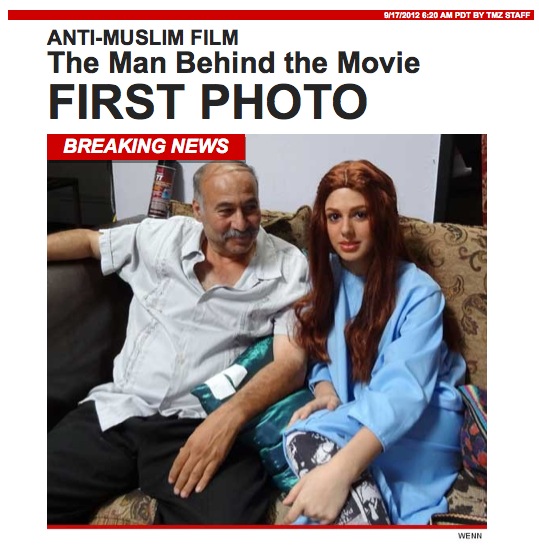
First published photo of Nakoula Basseley Nakoula, seen on the set of “Innocence of Muslims” with Anna Gurji, one of the actresses in the film. Screenshot from TMZ.com.
Like the fine, upstanding Coptic Christian he is, Youssef initially claimed to be Jewish, and insisted that his film had been funded by Jews. (I’m sure his new best friend Pastor Wiley Drake approves.) Once the press exposed those anti-semitic deceptions, the film’s origins in Egypt’s Coptic community and its allies on the fundamentalist U.S. right became clearer.
And David D. Kirkpatrick’s December 28, 2013 New York Times report on the 2011 consulate attack, “A Deadly Mix in Benghazi,” the most thoroughly researched press report I’ve read, states that “contrary to claims by some members of Congress, [the September 11, 2012 attack on the U.S. Embassy compound in Libya] was fueled in large part by anger at an American-made video denigrating Islam.”
What I wrote a year ago still holds: No major media outlet has explored the origins of this film in the radical Christian right in the States, despite ample evidence of that conspiracy.
•
This post supported by a donation from the Estate of Lyle Bongé.
No End of “Innocence”
Innocence of Muslims (Again)
Apparently it’s a gift that keeps on giving. There’s simply no end to the Innocence of Muslims story. Now the U.S. Ninth Circuit Court of Appeals has ruled that Google must remove from YouTube all current versions of Mark Basseley Youssef’s anti-Islam provocation. (Click here for Maura Dolan’s February 26, 2014 report in the Los Angeles Times.)
Though it didn’t rate even a mention at last year’s Oscars, this turkey ranks in my book as one of the major filmic events of 2012, just on the basis of its international impact. I consider that a notable achievement in lens-derived imagery, and incorporated its arrival on the global stage into my coverage of the imagistic component of Election 2012.
The grounds for the Circuit Court’s decision merit the attention of photographers and filmmakers. Per earlier reports, one of the actresses in the film, Cindy Lee Garcia, sued for its removal from YouTube after various Muslim clerics issued fatwas against the film’s producer, director, cast, and crew. Garcia premised an amended claim on the issue of copyright violation. In brief, she argued that she’d never signed a release for her performance, whose copyright and subsidiary rights thus remained hers. (Click here for the complaint, and here for a September 2012 clip of Garcia explaining her position.)
Beware of Synecdoche
Cindy Lee Garcia, “Innocence of Muslims” (2012), screenshot.
As I suggested in summarizing her filing in a February 20, 2013 post, “If true, that argument could in fact hold water. Absent such a release (click here for a standard version), Garcia would retain many rights to her performance, perhaps including approval of any published version.” Chief Judge Alex Kozinski of the Ninth Circuit Court and one of his two colleagues on that bench seems to have come to the same conclusion. It appears from the court’s written opinion that Google’s lawyers failed to produce as evidence any standard release or comparable documentation signed by Garcia.
Two important points: First, Garcia’s claim to copyright pertains only to the 5-second clip of her, the voiceover to which makes her appear to say “Is your Mohammed a child molester?” With that removed, anyone could re-post an edited version of the trailer on YouTube, and YouTube could leave it up without violating the court’s order. Presently, the only way for Google and YouTube to comply involves taking down the entire film, because they can’t excise that clip. But that’s not Garcia’s fault; her complaint does not constitute an attempt to prevent distribution of the entire 14-minute film.
Who Owns Your Image?
Second, dissenting Circuit Court Judge N. R. “Randy” Smith (one of former President George W. Bush’s appointees) surely errs when he asserts that an actor’s performance in a film is not copyrightable by the actor. Were that so, all legal obligations for an actor’s filmic performance would get fulfilled when the actor showed up to perform as instructed and the producer or his delegate paid the agreed-upon sum for that labor.
“Innocence of Muslims” (2012), screenshot.
In point of fact, standard film-industry practice involves the additional step of the performer signing a contract (commonly called a “release”) in which the performer “hereby give(s) [Production Company Name], their licensees, successors, legal representatives, and assigns the absolute and irrevocable right and permission to use my name and to use, reproduce, edit, exhibit, project, display, copyright, publish and/or resell photography images and/or moving pictures and/or videotaped images of me.” (My emphasis; click here for a standard version of this form, from which I’ve excerpted the preceding wording.) For the same reason, still photographers who intend to use images for commercial purposes commonly get their subjects to sign a comparable “model release.”
Since a film as a whole can be copyrighted, and said copyright covers all the individual performances conglomerated in the film, then those separate performances are subject to copyright. If the copyright and other rights listed in the release can be “given and assigned” by the performer to someone else, they must first be held by the performer. And, according to the law, copyright can’t get transferred “implicitly,” to use Judge Smith’s word; such a transfer requires written documentation.
“Innocence of Muslims” (2012), title card.
Garcia has claimed that she never signed any release such as the law requires. In the case of a claim of copyright violation the burden, contrary to Smith’s assertion, is not on the plaintiff to prove that no release or other transfer of rights exists; the defendant has the obligation to produce it. Unless and until Google’s lawyers (or Youssef) put into evidence a legally binding release, according to the law Garcia transferred no rights to Youssef, she retains copyright, and her fleeting but potent appearance in the film violates the law. If so, the same would hold true for the film’s other actors, should they pursue claims on the same grounds.
You don’t have to be a lawyer (and I’m not one) to understand that. I find it shocking that a judge on the Ninth Circuit Court — even a Dubya appointee — didn’t bother to inform himself about the basics of copyright law before issuing his dissent.
Please Welcome … The Supremes!
That’s quite aside from the issue of fraud. In the decision, made by a 2-1 majority, Judge Kozinski wrote, “The film differs so radically from anything Garcia could have imagined when she was cast that it can’t possibly be authorized by any implied license she granted. … A clear sign that Youssef exceeded the bounds of any license is that he lied to Garcia in order to secure her participation, and she agreed to perform in reliance on that lie. … Youssef’s fraud alone is likely enough to void any agreement he had with Garcia.” Presumably the fraud would include misrepresenting the nature and purpose of the film, as well as overdubbing Garcia’s recorded lines with someone else voicing anti-Muslim sentiments.
“Innocence of Muslims,” YouTube screenshot, February 28, 2014
The verdict, effective as of February 26, required Google to remove all copies of the film from YouTube within 24 hours and take “reasonable measures” to prevent it from being re-uploaded. As I write this, at 7 p.m. EST on February 26, the film is unavailable at Google.
The case has been sent back to a lower court, with instructions to issue a similar temporary ban. Google has pledged to appeal. Pending the outcome of that appeal, the court has ordered the video to remain offline. The case may end up before the U.S. Supreme Court.
Click here for legal expert Eugene Volokh’s analysis of the decision (with which he agrees), and his prediction of the grounds on which Google might pursue its appeal successfully. Click here for a strong dissent by Techdirt’s Mike Masnick, at the end of which you’ll find the actual court opinions (majority and minority), along with the court order.
“Innocence of Muslims” (2012), screenshot.
The video will remain online at other sites, including sites throughout the Middle East, so this action has mostly symbolic value vis-a-vis Garcia’s minor role in Youssef’s project. Whether this will get her off the hook with the mullahs (she’s received numerous death threats, and moved out of her home) remains to be seen. Maybe there’s an application process for that.
(Note: I’ve taken to referring to this provocateur as Mark Basseley Youssef because, according to several newspaper accounts, that’s his current legal name. The Circuit Court opinion lists him as follows: “Nakoula Basseley Nakoula, An Individual, Aka Sam Bacile; Mark Basseley Youssef; Abanob Basseley Nakoula; Matthew Nekola; Ahmed Hamdy; Amal Nada; Daniel K. Caresman; Kritbag Difrat; Sobhi Bushra; Robert Bacily; Nicola Bacily; Thomas J. Tanas; Erwin Salameh; Yousseff M. Basseley; Malid Ahlawi.” Right.)
Man About Town
Pastor Wiley Drake
Meanwhile, having served his time for assorted parole violations, Youssef was released from a Los Angeles prison on August 15, 2013, to a halfway house for completion of his sentence. On September 26, 2013, officially freed from federal custody, he left the halfway house, and was “released to Pastor Wiley Drake of First Southern Baptist Church in Buena Park,” which has “taken him in.”
Apparently, as Youssef has adamantly refused to make any apology for his debut production, this means that he’s in hiding from Islamists eager to fulfill the fatwa still in effect against him.
Drake, a controversial minister and radio host, was the vice-presidential candidate for the America’s Independent Party ticket in California in 2008. An advocate of “imprecatory prayer,” which involves beseeching the Almighty to afflict and destroy evildoers, Drake has prayed for the death of President Obama. Strange bedfellows, he and Youssef (not that there’s anything wrong with that). I wouldn’t care to sample whatever they’ll cook up together.
Now Read the Book
While doing his time in the pokey, the man behind Innocence of Muslims, under the name Nakoula Basseley Nakoula, supposedly penned a self-published book he calls Innocence. Published on August 28, 2013 (just after his release from prison), paperback in format, 356 pages long (or maybe 314, or maybe 292). Listed at $22.49, this work claims to contain “The original script & storyboards for Innocence of Muslims.” Amazon’s main page for the book lists the publisher as Basseley Nada, but the book’s title page gives it as KTMA Co. Press. ISBN 13: 9780615873121 ISBN 10: 061587312X.
Nakoula Basseley Nakoula, “Innocence” (2013), cover
Nakoula/Youssef writes, “I dedicate this book to Ambassador Chris Stevens, Information Officer Sean Smith, former Navy Seals Tyrone Woods, and Glen Doherty; and to every son who has lost his father; to every mother or father who has lost her son or daughter; and to every person all over the world lost his life [sic] or has been injured because of the culture of death and terrorism. I would like to tell you all you are not forgotten.”
You’ll find that dedication, and the publishing information about the book, at Amazon. Along with this statement: “Out of Print–Limited Availability.” The “Look Inside” feature at ChezBezos shows several storyboards and scraps of script, plus Nakoula/Youssef’s introduction.
I qualify my description of its contents carefully because I can find no evidence whatsoever that this book actually exists. It has received no reviews or online discussion — certainly odd for so immediately high-profile and controversial a work. No bookseller has a used copy listed for sale, at any price; all listings of it show it as “sold out,” “out of stock” or “out of print.”
I’ve come across no indication that anyone anywhere has even laid eyes on a copy, much less read it. Given that Youssef has repeatedly asserted the existence of a feature-length version of Innocence of Muslims, though no one has ever seen it, I incline to the view that the book is also a fabrication.
The Responsibility of Coptic Christians
First published photo of Nakoula Basseley Nakoula, seen on the set of “Innocence of Muslims” with Anna Gurji, one of the actresses in the film. Screenshot from TMZ.com.
Like the fine, upstanding Coptic Christian he is, Youssef initially claimed to be Jewish, and insisted that his film had been funded by Jews. (I’m sure his new best friend Pastor Wiley Drake approves.) Once the press exposed those anti-semitic deceptions, the film’s origins in Egypt’s Coptic community and its allies on the fundamentalist U.S. right became clearer.
And David D. Kirkpatrick’s December 28, 2013 New York Times report on the 2011 consulate attack, “A Deadly Mix in Benghazi,” the most thoroughly researched press report I’ve read, states that “contrary to claims by some members of Congress, [the September 11, 2012 attack on the U.S. Embassy compound in Libya] was fueled in large part by anger at an American-made video denigrating Islam.”
What I wrote a year ago still holds: No major media outlet has explored the origins of this film in the radical Christian right in the States, despite ample evidence of that conspiracy.
•
This post supported by a donation from the Estate of Lyle Bongé.